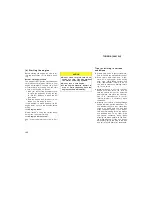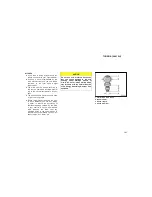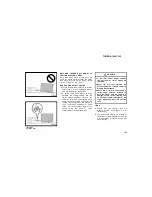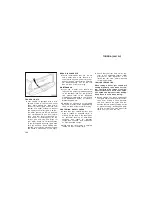
TUNDRA (34413U)
195
!
Backing with a trailer is difficult and
requires practice. Grip the bottom of
the steering wheel and move your hand
to the left to move the trailer to the
left. Move your hand to the right to
move the trailer to the right. (This pro-
cedure is generally opposite to that
when backing without a trailer). Also,
just turn the steering wheel a little at
a time, avoiding sharp or prolonged
turning. Have someone guide you when
backing to reduce the risk of an acci-
dent.
!
Because stopping distance may be in-
creased,
vehicle- to- vehicle
distance
should be increased when towing a
trailer. For each 16 km/h (10 mph) of
speed, allow at least one vehicle and
trailer length between you and the ve-
hicle ahead. Avoid sudden braking as
you may skid, resulting in jackknifing
and loss of control. This is especially
true on wet or slippery surfaces.
!
Avoid jerky starts or sudden accelera-
tion. If your vehicle has a manual
transmission, prevent excessive clutch
slippage by keeping engine rpm low
and not racing the engine. Always start
out in first gear.
!
Avoid jerky steering and sharp turns.
The trailer could hit your vehicle in a
tight turn. Slow down before making a
turn to avoid the necessity of sudden
braking.
!
Remember that when making a turn,
the trailer wheels will be closer than
the vehicle wheels to the inside of the
turn. Therefore, compensate for this by
making a larger than normal turning
radius with your vehicle.
!
Crosswinds and rough roads will ad-
versely affect handling of your vehicle
and trailer, causing sway. Pay attention
to the rear from time to time to pre-
pare yourself for being passed by large
trucks or buses, which may cause your
vehicle and trailer to sway. If swaying
happens, firmly grip the steering wheel
and reduce speed immediately but
gradually. Never increase speed. Steer
straight ahead. If you make no extreme
correction with the steering or brakes,
the vehicle and trailer will stabilize.
!
Be careful when passing other ve-
hicles. Passing requires considerable
distance. After passing a vehicle, do
not forget the length of your trailer and
be sure you have plenty of room be-
fore changing lanes.
!
In order to maintain engine braking effi-
ciency, do not use fifth gear (manual
transmission) or overdrive (automatic
transmission).
!
Because of the added load of the trail-
er, your vehicle’s engine may overheat
on hot days (at temperatures over
30
°
C [85
°
F]) when going up a long or
steep grade with a trailer. If the engine
coolant temperature gauge indicates
overheating, immediately turn off the air
conditioning (if in use), pull off the road
and stop in a safe spot. Refer to “If
your vehicle overheats” in Part 4 of
this manual.
!
Always place wheel blocks under both
the vehicle and trailer wheels when
parking. Apply the parking brake firmly.
Put the transmission in “P” (automatic)
or in first or reverse (manual). Avoid
parking on a slope with a trailer, but
if it cannot be avoided, do so only
after performing the following:
1. Apply the brakes and hold.
2. Have someone place wheel blocks un-
der both the vehicle and trailer wheels.
3. When the wheel blocks are in place,
release your brakes slowly until the
blocks absorb the load.
Содержание 2000 Tundra
Страница 10: ...TUNDRA 34413U 8 ...
Страница 20: ...TUNDRA 34413U 18 ...
Страница 78: ...TUNDRA 34413U 76 ...
Страница 86: ...TUNDRA 34413U 84 ...
Страница 96: ...TUNDRA 34413U 94 ...
Страница 146: ...TUNDRA 34413U 144 ...
Страница 154: ...TUNDRA 34413U 152 ...
Страница 166: ...TUNDRA 34413U 164 ...
Страница 182: ...TUNDRA 34413U 180 ...
Страница 200: ...TUNDRA 34413U 198 ...
Страница 226: ...TUNDRA 34413U 224 ...
Страница 232: ...TUNDRA 34413U 230 ...
Страница 244: ...TUNDRA 34413U 272 Fuse type C 39 ALT 120 A All components in AM1 ALT S HTR FR FOG PWR OUTLET 1 and PWR OUTLET 2 fuses ...
Страница 250: ...TUNDRA 34413U 278 ...
















































